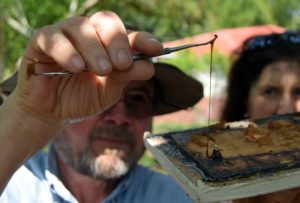Socorro, Colombia, Mar 14 (EFE).- Bees do not sting German Perilla even if he opens their hives with his bare hands. The scientist from George Mason University has been working with the insects for 40 years and now he is bringing his knowledge to a village in northeastern Colombia.
Perilla is in Socorro as part of the US university’s Honey Bee Initiative, which is also supported by Industrial University of Santander (UIS) and BBVA Colombia bank.
The objective is to develop and empower the farming communities through beekeeping, so that they can become self-sufficient over the long run in a region, like many others in Colombia, that was hit hard by the country’s decades-long armed conflict.
What started as a trial in three municipalities that benefited 20 families is now a well-established project, with 160 families from nine villages participating.
Until now, beekeeping has been developing slowly and on a small scale.

“With this operation, we’re seeing that (the participants) are being incorporated in a much more direct way and are much more motivated. The support is allowing this sector to be promoted in a much more efficient manner,” says UIS academic coordinator Giovanni Monsalve.
In its first year, 900 kg (1,982 lbs) of honey were taken out of local hives, an average of 25 kg each, and in the near future, the the plan is for process to become much more industrialized.
Johana Mesa has 13 beehives with about 10,000 bees in each on the La Vega farm, which belongs to her inlaws.
She is in charge of dealing with the insects because her husband is allergic to them, she says.
Leading a group of seven journalists with a smoker on hand to scare the bees away is German Perilla, with Mesa carrying another smoker and bringing up the rear. Wearing protective suits to guard against bee stings, they lead the group to the hives; yet, the scientists has his hands uncovered, since he claims that bees do not sting him.
He says that the key is to treat them gently as he uncovers one of the hives to show the honey deposits. With the same delicacy, he opens one of the tiny wax cells from which a young bee is emerging.
“You are privileged to be seeing this,” he says enthusiastically wreathed in dense white smoke.
Nearby, Vidal Pinto doesn’t want to talk in detail about the armed conflict. “There were guerrillas but they were far away. They didn’t come here,” he said while sitting in the shade of a porch on his farm, now taken over by some 30 George Mason students who have come to see the project.
When he was young, this frail-looking octogenarian worked with bees and he is now one of the beneficiaries of the project.
“We only welcome those who have bee experience, because then you don’t have to indoctrinate them that this is good,” he says.
“Anyone who’s been involved with bees knows it’s good.”
George Mason has set no deadline for supporting this initiative.
“At the time when the industrialization part is created or we can create an export system, the university will be on hand because we’re the gateway for the United States,” says Perilla.
The circling buzzards are the only creatures in the clear sky, with its hot midday sun. During the early afternoon, between noon and 3 pm, the bees are more sensitive and defend their hives more aggressively.
